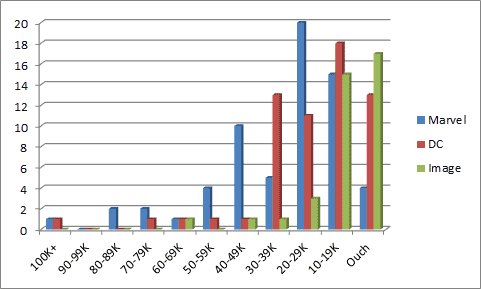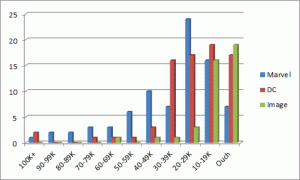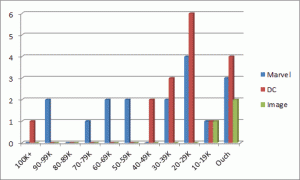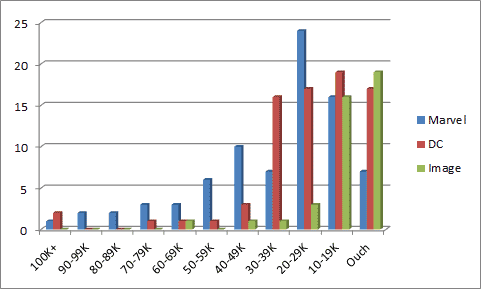Yes, the *total* number of comics sold in a month still sounds impressive, but what about the individual books? It’s time to check in on an exercise I call “the sales bands.” A sales band is how many titles sell within a range of sales. I find it useful to divide the chart up in 10,000 copy increments. We can see how many titles sell between 90-99K and 20-29K. It lets us see where most issues fall and what’s really good sales in the current market. While we’re at it, let’s see what we can do about peeling back that layer of stunt publishing and have a look at how the core market is doing.
For the first pass, let’s go to the Comichron February estimates and take a look at what the sales bands look like if we take out the mini-series, the first issues and the second issues. Eliminate the Events, the first issue sales with the inflated numbers from variants and anyone brave enough to be a speculator and the second issues, which tend to also be a bit inflated. The idea is to get a look at what the sustainable, ongoing sales are. Are the core publishing lines capable of surviving on their own without stunts to gin up the sales numbers?

What do we see when we take the special events and relaunches out?
Not very much selling over 49K per issue, that’s for sure.
Marvel has a chunk of comics selling in the 40K-49K range. This includes much of the Avengers and X-Men families of titles. Those are titles you’d expect to be in somewhere between 60K-80K (at least) this soon after a relaunch and to be relaunched before they slide down to the 40-49K sales band. And I’m not seeing 20K worth of second printings on any of these titles, either. But, looking at the sales chart, if a Marvel book is selling over 40K/month, that’s about as much as the market is allowing for the top tier. It would have been mid-list not too many years ago.
Over at DC, you don’t see any accumulation of titles until the 30-39K sales band. I included Batman Eternal because, while it’s technically a mini-series, it’s a reoccurring series that’s been around more often than not in the last two years. And DC’s chart is cruel enough without redacting Batman Eternal. As strange as it sounds, if a title is breaking 30K for DC, it’s basically a hit book for them. There’s just a handful of titles in the 40K+ range for ongoings.
When we get to the 20-29K band, there’s a significant uptick in Marvel titles. The highest number of Marvel titles fall is this band. Now, if you consider 20K in DM sales to be the cancellation line, for which titles need to be sweating it if they fall below, this is the last zone of safety… although the closer to 20K a title gets, the slipperier the slope.
We get in that 10K-19K range and you can tell that things aren’t really going as planned for DC and Marvel. This is actually the highest title count band for DC, although it does include some Vertigo and kids titles that are effectively judged by different measuring sticks. If it’s a mainstream DC or Marvel title and it’s in this sales band, you hope it’s towards the top. While both DC and Marvel have shown a little more tolerance in recent years for sub-20K sales, this is where the cancellations come from.
This is also the area where Image starts to show up in force. Depending on the mainstream page rate of the creators on a given comic and what the cover price is, you start seeing the monthly income from an Image comic aligning with DC/Marvel entry level page rates at around 10K sales. If the cashflow works properly, Image creators in this bracket should be roughly breaking even or ahead on their monthly check and then anything that comes from the collected editions is pure gravy.
*Most* of the DC/Marvel titles you’ll see in the under 10K range (AKA “Ouch”) are sub-imprints and/or targeted for younger readers. Not all of them, though. With Image, this is where you see the creators who haven’t defected from DC and Marvel earning their stripes. It’s not really an “ouch” for Image, so much as their second sales tier and this part hasn’t really changed in recent years. If anything, the Image second tier has moved up slightly.
So what does the chart look like with all the #1s, #2s and mini-series kept in it?


As you can see, DC’s taking the big “publishing stunt” prize for Dark Knight III, then Marvel fills in the higher sales bands and both DC and Marvel have their most activity in the 20-29K range.
It’s that top half that’s what we need to pay attention to, though. It’s just so common for DC and Marvel to publish titles that fall in that 20-29K circulation range, those special events and stunts that sell well take on more value as a result.
Take Dark Knight III for example. It’s estimated at 146K copies. If you put the typical title for DC or Marvel in the middle of that 20-29K range, call it 25K, Dark Knight III is worth six issues of a typically selling comic. This gets to the heart of DC’s “Rebirth” strategy. It’s a far better thing to sell two issues of Batman at 90K-100K copies than one issue of Batman at 100-110K and one issue of (for example) Catwoman at ~13.6K, as Catwoman was estimated to sell in February. Most titles are likely to take a slight drop when they require a two issues/month commitment, but we’ll have to see how that shapes up in practice.
It’s not a new idea. Marvel’s been at 18 issues per year on their better selling titles for some time now. It does illustrate the current reality, though.
On the whole, the stories you read about how great the comics sales are boil down to more issues of lower selling titles. The big hits aren’t as common and when the BIG hits drop, they tend to be Events and aided by variant covers. The ongoing series — the normal issues, if you will — keep drifting down. Even the current Big Three titles of Star Wars, Batman and Darth Vader have been drifting down a bit in recent months. Scott Snyder and Greg Capullo aren’t going to be making Batman comics forever and DC is going to have BIG shoes to fill when those two say their final farewells to the franchise. The “normal,” ongoing title have softer sales for the most part.
It’s the mid-list and below that’s driving the market, except it isn’t the really what we would have called the mid-list 5 years ago.
Take a good hard look at all those titles clustered between 20K-39K. If you hear creators lamenting a decline in royalties, they likely aren’t exaggerating. Diamond will be just fine with more small titles. The publishers will be OK if they can pump out enough of them, although the standard attrition will start making that a bit more extreme if it keeps up. Of course, the more titles you publish, the more sales get split between titles. It’s a lot like cable sapping the broadcast network ratings.
Retailers could use a few more hits. Low copy per issue sales makes it harder for them to order copies for the shelf (hence the constant creator requests for readers to pre-order). Having a few titles that sell 100 copies each makes it a lot easier on the ledger to have a shelf copy of one of those lower selling titles sitting on the shelf. Without the big hits, there’s more incentive to take it easy on the shelf copies and err on the side of caution.
It’s a strange time as we wait for Rebirth and Civil War II and the Big Two’s attempt to get some higher per issue sales in the mix.
Want to learn more about how comics publishing and digital comics work? Try Todd’s book,Economics of Digital Comics.






Interesting – a fun analysis would be looking at this with some year over year analysis and inclusion of digital assumptions. I always love these articles re:sales even though I am rarely included in them. I read an absurd amount of comics, but from non-comic store options. Be it digital (Unlimited, Hoopla, Comixology, secondary digital code market, humble bundles, etc.), book stores and libraries. I buy maybe 2 to 5 comics a month in traditional comic stores. I always wonder how these non-Diamond channels influence the individual titles and sales. Also, wondering about the trend of people like me – especially with younger readers.
Also agree that Star Wars is bringing in new readers – including my daughters. They cant believe that there is more Princess Leia, Chewbaca and Darth Vader stories. (They are 3, 4 & 6 so ther minds are easily blown).
Thanks for the article Todd.
Ohh — what if there was analysis of bookscan (previous Hibbs article) and end of year 2015 Diamond numbers….. I think this would be a fun idea for John Jackson at comichron or they Mayo report.
Great article. It really seems to underscore the ongoing diversity of the market since more people are collecting different titles as opposed to migrating in greater numbers to traditional super hero titles.
You should probably note that those numbers represent NA asks only. No Diamond UK sadness are included, no digital sales are included. And then let’s not forget the comics are licensed out for translation.
Does any one actually know what percentage those bits would add on top?
Paul, Diamond UK has always been estimated in the 20% range, though there hasn’t been any “official” notation of that number in like a decade?
Digital is generally understood to be somewhere in the 15% rage, and hasn’t grown significantly in the last couple of years.
I can’t imagine how one would calculate foreign translations — especially since one assumes that the majority of US comics are probably 0% (or close to that)
-B
@Brian Hibbs
At least in Italy, but I guess in France, Germany and Spain too, many Marvel and DC books are published, both in the news stand market and in the comic shop / library market. In Italy many Image books are published too, in volumes for comic shops and libraries. I read american comics in english, but in italian book stores I’ve seen translated editions of Chew, Saga, Sex Criminals, Alex + Luna, Southern Bastards, Bitch Planet, Descender, East of West, Pretty Deadly, obviously The Walking Dead and other Image titles.
FIX: its “in volumes for comic shops and bookstores” not “and libraries”
Comments are closed.